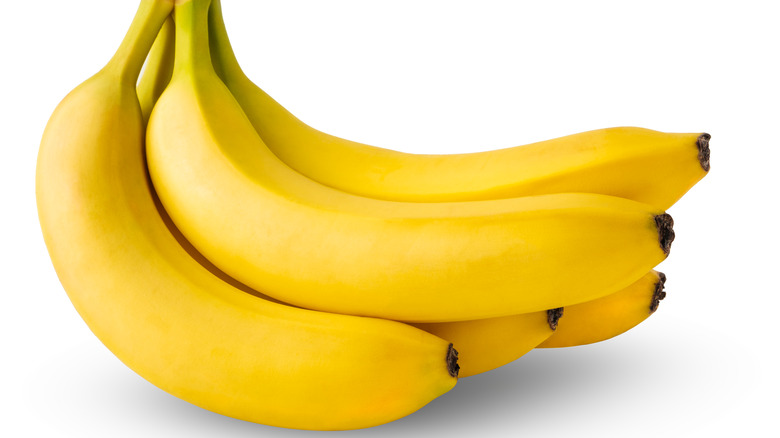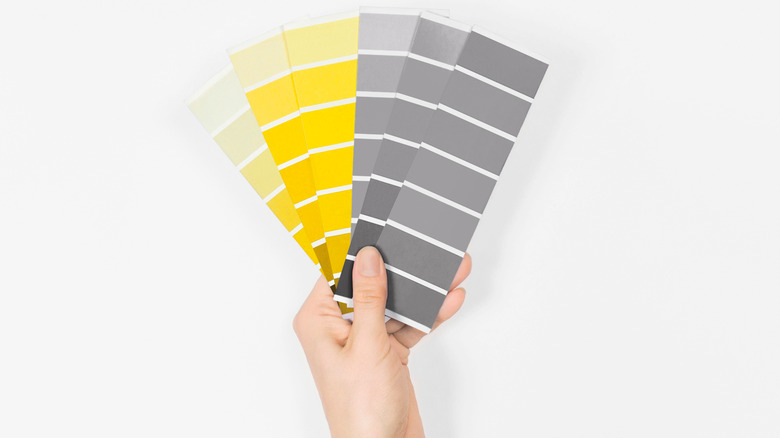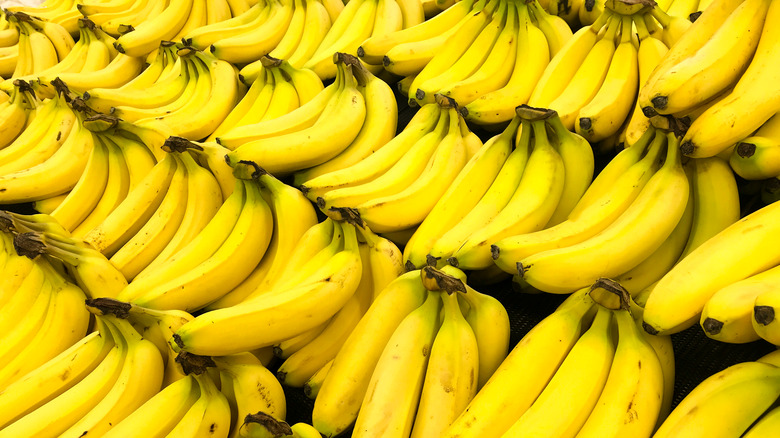The Sneaky Way Grocery Stores Try To Make Banana Displays Look Appealing
It has been said that life is a bowl of cherries, but in reality, life is more like a bowl of fruit salad. Many of us consume a variety of fruits each day (think apples, oranges, grapes, and strawberries), but only one fruit can claim to be the top banana, and that fruit is, well, the banana (per Statista). A 2021 survey revealed that the tropical fruit is ap-peeling indeed: 63% of adults polled said they had purchased bananas in the last year. Now, picture a pile of bananas, because that's what the average person eats in a year — more than 26 pounds of them. You could say we go bananas for bananas.
Because they're such a fan-favorite fruit, supermarkets treat bananas extra nice, giving them space at the front of the produce department to bring you in, or in the back, to lure you through the entire department — where you might pick up a couple of other things (per Produce Business). They're also sprinkled throughout the store, say in the cereal aisle, near the ice cream freezers (for banana splits), and in the vicinity of Nutella — because who can resist bananas and Nutella?
Most importantly, merchandisers keep a sharp eye on bananas to make sure they're a certain shade of yellow. That very specific shade of yellow is Pantone color 12-0752, also known as "Buttercup" (per Mental Floss).
Presenting bananas in their best color and light
The Pantone Color System, introduced in 1963, is considered a "universal language” of color. It was designed to work across fields like printing, and fashion, product, and graphic design, to bring about color uniformity (per Pantone). The Pantone Color Institute forecasts a "Color of the Year” for each year — the "it" color for 2023 is Viva Magenta 18-1750 — and the institute is recognized as an authority on everything related to color, including the psychology of color.
The psychology of color is why Pantone color 12-0752 "Buttercup” comes into play in the produce department: Shoppers are most likely to add bananas closest to this shade to their shopping carts, so marketers strive mightily to make sure their banana displays glow with "Buttercup” yellow, according to Martin Lindstrom, author of "Brandwashed: Tricks Companies Use to Manipulate Our Minds and Persuade Us to Buy,” (per Mental Floss). Look above the banana display at stores like Target or your favorite supermarket and you might see special lighting to make the bananas look even more favorable, begging you to bring them home.
Make good use of green and brown bananas
Of course, you're likely to find bananas of varying colors ripe (or unripe) for picking at the grocery store. While most of us seem to like Pantone 12-0752 "Buttercup” yellow bananas best for eating out of hand and slicing into yogurt bowls or on top of cereal, there are ways to put the full spectrum of bananas to use in recipes.
If you can't wait for green bananas to ripen or if they stubbornly refuse to ripen even after spending some time in a ripening bag, you can boil them, bake them, or slice them up and fry them (in the form of chips or fries, per Treehugger). Unripe bananas can also be added to smoothies – they taste a bit less banana-y than ripe bananas. Green bananas can also be used in recipes that call for plantains, a tropical fruit that's similar to the banana, but generally eaten cooked.
Very ripe or overripe bananas can be used in waffles, pancakes, oatmeal, banana bread, and nice cream — dairy-free frozen dessert made with bananas. One TikTok user, @loveofearthco, recommends a healthy, zero-waste, lactose-free dessert made with frozen ripened bananas, plant milk, strawberries, and cocoa powder. If you don't want to use them now, stash sliced bananas or banana mash in the freezer and use it later. Ripened and over-ripe bananas tend to be sweeter, so you might be able to cut back a bit on added sugar.


